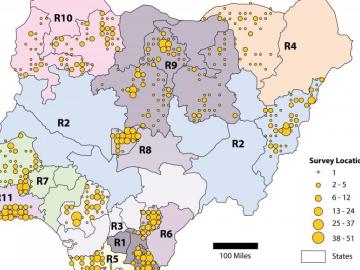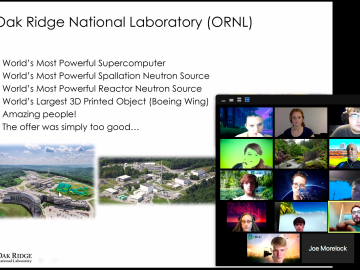
Filter News
Area of Research
- (-) Biology and Environment (177)
- (-) Fusion and Fission (54)
- (-) National Security (80)
- Advanced Manufacturing (34)
- Biological Systems (18)
- Biology and Soft Matter (5)
- Building Technologies (12)
- Chemical and Engineering Materials (4)
- Chemistry and Physics at Interfaces (11)
- Clean Energy (522)
- Climate and Environmental Systems (14)
- Computational Biology (6)
- Computational Chemistry (5)
- Computational Engineering (5)
- Computer Science (19)
- Data (1)
- Earth Sciences (1)
- Electricity and Smart Grid (3)
- Energy Frontier Research Centers (14)
- Energy Sciences (5)
- Fossil Energy (3)
- Fuel Cycle Science and Technology (3)
- Functional Materials for Energy (16)
- Fusion Energy (17)
- Geographic Information Science and Technology (3)
- Isotope Development and Production (3)
- Isotopes (35)
- Materials (433)
- Materials Characterization (2)
- Materials for Computing (36)
- Materials Synthesis from Atoms to Systems (13)
- Materials Under Extremes (12)
- Mathematics (1)
- Neutron Data Analysis and Visualization (4)
- Neutron Science (190)
- Nuclear Science and Technology (74)
- Nuclear Systems Modeling, Simulation and Validation (3)
- Nuclear Systems Technology (1)
- Quantum Condensed Matter (4)
- Quantum information Science (9)
- Reactor Technology (1)
- Renewable Energy (4)
- Sensors and Controls (5)
- Supercomputing (311)
- Transportation Systems (11)
News Topics
- 3-D Printing/Advanced Manufacturing (15)
- Advanced Reactors (8)
- Artificial Intelligence (22)
- Big Data (15)
- Bioenergy (47)
- Biology (74)
- Biomedical (18)
- Biotechnology (13)
- Buildings (4)
- Chemical Sciences (16)
- Clean Water (11)
- Climate Change (43)
- Composites (6)
- Computer Science (37)
- Coronavirus (15)
- Critical Materials (2)
- Cybersecurity (19)
- Decarbonization (22)
- Energy Storage (11)
- Environment (92)
- Exascale Computing (6)
- Fossil Energy (1)
- Frontier (5)
- Fusion (23)
- Grid (11)
- High-Performance Computing (25)
- Hydropower (8)
- Isotopes (3)
- ITER (6)
- Machine Learning (19)
- Materials (13)
- Materials Science (12)
- Mathematics (3)
- Mercury (7)
- Microscopy (11)
- Molten Salt (1)
- Nanotechnology (9)
- National Security (35)
- Net Zero (3)
- Neutron Science (7)
- Nuclear Energy (32)
- Partnerships (12)
- Physics (4)
- Polymers (2)
- Quantum Science (1)
- Renewable Energy (1)
- Security (13)
- Simulation (17)
- Space Exploration (1)
- Summit (12)
- Sustainable Energy (35)
- Transformational Challenge Reactor (1)
- Transportation (7)
Media Contacts

New capabilities and equipment recently installed at the Department of Energy’s Oak Ridge National Laboratory are bringing a creek right into the lab to advance understanding of mercury pollution and accelerate solutions.

The Transformational Challenge Reactor, or TCR, a microreactor built using 3D printing and other new advanced technologies, could be operational by 2024.

Popular wisdom holds tall, fast-growing trees are best for biomass, but new research by two U.S. Department of Energy national laboratories reveals that is only part of the equation.

Department of Energy Under Secretary for Science Paul Dabbar joined Oak Ridge National Laboratory leaders for a ribbon-cutting ceremony to mark progress toward a next-generation fusion materials project.

Oak Ridge National Laboratory scientists helped count the population of Nigeria – all without leaving the lab.

Two staff members at the Department of Energy’s Oak Ridge National Laboratory have received prestigious HENAAC and Luminary Awards from Great Minds in STEM, a nonprofit organization that focuses on promoting STEM careers in underserved

Horizon31, LLC has exclusively licensed a novel communication system that allows users to reliably operate unmanned vehicles such as drones from anywhere in the world using only an internet connection.

Each summer for the last 30 years, students and teachers from across Appalachia have travelled to ORNL for a unique STEM summer camp experience – the Appalachian Regional Commission/ORNL Science-Technology-Mathematics Institute.

A team led by Dan Jacobson of Oak Ridge National Laboratory used the Summit supercomputer at ORNL to analyze genes from cells in the lung fluid of nine COVID-19 patients compared with 40 control patients.

From materials science and earth system modeling to quantum information science and cybersecurity, experts in many fields run simulations and conduct experiments to collect the abundance of data necessary for scientific progress.


